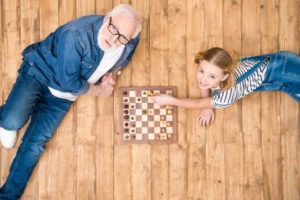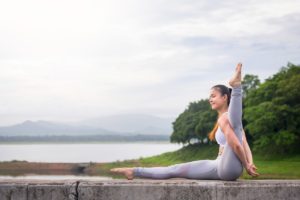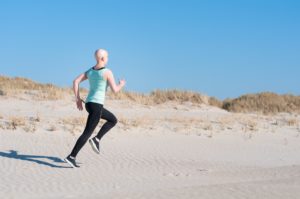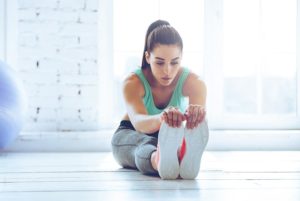Flexibility
Balance and Stability
Balance, which is essential for integrated movement, declines as we age. However, you can teach group fitness students how to maintain balance while also taking them through some fun, creative core exercises. Having a strong trunk and hip complex helps us maintain balance for years to come. In your next class, incorporate these multiplanar exercises targeting the core musculature and the gluteals. Each move is done in a standing position, and equipment is optional. Encourage attendees who struggle with balance to perform these exercises against a wall or while holding onto a barre.
Cool Down With Reciprocal and Autogenic Inhibition Techniques
As you wind down your dance, step, strength or boot camp class, many attendees are uncoupling from your intentional instruction and preparing for the next stop in their busy days. Don’t let participants leave without a solid cooldown experience! Next time, as you lead the stretch, why not share a little science with them?
How Fast You Walk May Affect How Long You Live
Want to outwalk the grim reaper? Pick up the pace, say researchers. A new study from the United Kingdom suggests that quicker walking may add years to your life.
The study’s primary aim was to examine the impact of walking pace and volume on all-cause mortality. To determine this, researchers looked at mortality records for 50,225 individuals from Scotland and England who had self-reported their walking data via interview.
Teaching Yoga at the Wall
As a yoga teacher, you guide participants through a practice that deepens their understanding of asanas (poses) and how these take shape in students’ bodies. You cue, coach, align, adjust, demonstrate and discuss, and you offer tips on breathing, anatomy, “feel” and sensation. Often, the most effective way to help participants understand a specific element is to slow down, grab a prop or two, and work a little deeper. You may have access to straps, blocks and bolsters, but you might be forgetting another perfect “prop”: the wall.
Stand Up to Aging
Getting up off the ground grows more difficult as we age. Muscles and bones weaken, coordination becomes less fluid, and simply doing chores around the house gets more challenging. Ground-to-standing (G2S) exercises address these changes. hile even performance athletes can benefit from G2S drills (see the sidebar “G2S Exercises Also Help Performance Athletes”), they’re supremely helpful for older exercisers who are at risk for broken hips and other threats to their mobility.
Thai Yoga Improves Flexibility
If your clients need to improve their flexibility, you may want to encourage them to try Thai yoga during their time away from training. In a review of randomized controlled trials, researchers found that consistent practice of Thai yoga improved muscular flexibility and specific joint range of motion. Thai yoga is from traditional Thai medicine and includes gentle dynamic stretching, deep breathing, meditation and self-acupressure.
The Subtalar Joint: An Important Link in the Kinetic Chain
You may have noticed that many of your clients are blissfully unaware of just how much work the foot and ankle complex does—unless and until, of course, an ankle sprain or tendinitis occurs. The ankle “negotiates” ground reaction forces, informing the kinetic chain in numerous ways. Among other functions, the feet and ankles help the body adapt to uneven terrain through side-to-side movement (Price 2008).
NEAT Exercise for the Brain
Have you heard that prolonged sitting can be as bad for health as smoking (Owen, Bauman & Brown 2008)? The good news is that movement can help, and it doesn’t have to be a marathon. One avenue worth exploring is nonexercise activity thermogenesis (NEAT). NEAT encompasses the calories burned while living life: walking to work, fidgeting, typing, folding clothes, washing dishes, running errands and so on; only sleeping, eating and sports are not included (Levine & Yeager 2009).
Walking Speed: A Predictor of Functional Health
Slow walking speed has been linked to a greater risk of mortality in older adults, while brisk walking has been linked to better health.
Spotting and Fixing Flaws in Walking Biomechanics
Participating in a program of regular exercise is a good idea at any stage of life, but particularly as we get older. Exercising frequently and consistently has many documented benefits, including promoting good health, preventing disease, enhancing mental health and physical capacity, aiding recovery from injury and illness, minimizing the effects of aging, and improving one’s ability to handle the physical demands of life (Bird, Smith & James 1998).
Pillars of Functional Training for Active Aging
Healthy aging is more than the absence of disease, according to the World Health Organization (WHO): “For most older people, the maintenance of functional ability has the highest importance” (WHO 2015). Colin Milner, founder and CEO of the International Council on Active Aging in Vancouver, British Columbia, echoes these comments. “When looking at the healthy aging market today, the focus is all about function,” he says.
Creative Ideas That Inspire
Cardio Sweat Party, at Power Studios in New York City, was designed by Michele Gordon. It combines kickboxing with dance, athletic drills and upbeat music for a 55-minute, high-energy experience. Classes are open to all fitness levels, and each class begins with a dynamic, kickboxing- based warmup before moving into three to four segments of choreography. In between the choreographed moves, rounds of squats, lunges, jacks, burpees, mountain climbers and other athletic drills round out the experience.
Why Proper Rib-Cage Position Is Important
Proper thoracic-cage functioning sets the groundwork for healthy movement.
Fitness and Flexible Blood Vessels
Clients often focus on the many aesthetic benefits of exercise, including weight loss and improved skin tone (Jaret 2011). Remind your hard-working clients of the numerous other benefits they’re reaping when they’re repping—the good stuff that happens behind the scenes, or rather, beneath the skin.
Mind-Body Exercise and Menopause
Are you in menopause? Chances are that you sometimes feel that you are not in control of your body! If you are seeking ways to cope with unpleasant menopausal symptoms, you may want to try yoga and other mind-body practices.
Shirley Archer, JD, MA, 2008 IDEA Fitness Instructor of the Year, an award-winning author and IDEA’s mind-body spokesperson, explains the research and application of mind-body exercise on menopause.
Irritability and Mood Swings
Preventing Golf Injuries
As a golfer, you want to stay injury-free to practice and compete regularly, which ultimately lets you hone your skills and elevate your performance.
To help avoid injury and boost level of play, you need to understand how two key muscle and soft-tissue systems—the posterior oblique system and the anterior oblique system—affect the golf swing.
Why Cross-Train Flexibility?
In nearly 40 years as a fitness educator, I have never been sidelined by a significant injury, in spite of decades of high-impact classes, rigorous weight training, participation in competitive aerobics, and group exercise schedules that sometimes exceeded 25 hours per week. I attribute my longevity in this grueling business to one thing—cross-training all aspects of fitness, including flexibility.
Barre Booming
As a hot trend, barre continues to lead conditioning activities, with an impressive 12% growth rate in 2015, according to 2016 Tracking the Fitness Movement: The Annual Review of Fitness Participation in America, conducted by the Sports & Fitness Industry Association. Tai chi also continued to see healthy growth in 2015, with a 6% jump.
Training the Pelvic Core
"I wish someone had told me this could happen to my body after having a baby!" . . . "Why did my doctor tell me I could return to exercise at my 6–week checkup?"
Pilates For Postmenopausal Women?
Can Pilates mat exercises help early postmenopausal women to gain strength and flexibility and reduce menopausal symptoms? Korea University researchers wanted to find out, as little research exists on this group.
- « Previous
- 1
- 2
- 3
- 4
- Next »



















